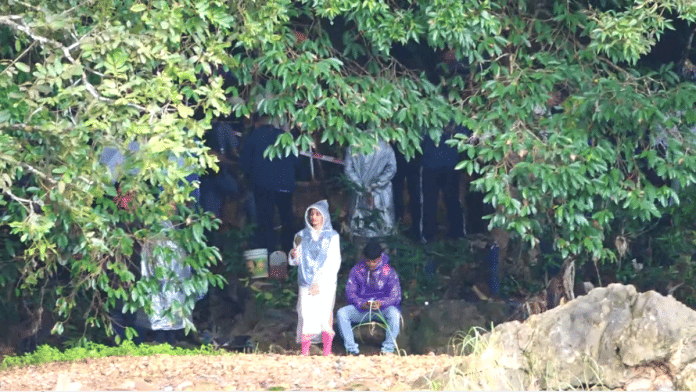Bengaluru: Partial skeletal remains were recovered Thursday from Site 6 on the third of the excavation being carried under the watch of a Special Investigation Team (SIT) in its probe into the alleged mass burials in the temple town of Dharmasthala, according to people aware of the developments.
The unearthing of these remains from one of the sites—identified by a former sanitation worker—marks a breakthrough in the probe even as it is yet to be confirmed whether it was that of the alleged victims of murder, rape and torture.
The SIT had ordered digging at multiple locations in and around the Nethravathi river and along the dense forests of the Western Ghats since Tuesday morning. Rains, however, have affected the progress of exhumation.
Of the 13 spots, the SIT led by senior IPS officer Pronab Mohanty has completed excavations in six locations in an ascending order, according to people aware of the developments. “Some skeletal remains have been found in the sixth identified location,” one of them said Wednesday.
There were reports stating that the first eight marked spots are located beside the river and the complainant is purported to have emphasised on the possibility that the bodies got washed during floods in the past.
On 4 July, the Dakshina Kannada lodged an FIR based on the statement of former sanitation worker, who is now the complainant, that he was coerced by people “connected to the Dharmasthala temple administration and other staff members” into burying or disposing of bodies.
On Wednesday, excavation was carried out even as it has been raining incessantly for weeks now in the coastal district of Dakshina Kannada.
However, one person directly aware of the developments says that the excavation is only one part of the long-drawn process. “Finding skeletons is not the objective of the SIT but determining the cause of death is,” a senior police officer told ThePrint.
There are records of people being legally buried in several such spots around the river and forest around Dharmasthala, the officer explained.
The officer added that recovery of skeletal remains would be projected as a vindication of claims made by one section of people, alleging multiple instances of murder, rape and torture by members of an influential and powerful family in the region.
Also Read: The dead speak in Dharmasthala. Sinister story behind temple town’s mass graves, unearthed
‘Skeletal remains not enough’
Currently under witness protection, the complainant has submitted in his statement that he was coerced into burying or disposing of ‘hundreds’ of bodies between 1995 and 2014.
But, the above-mentioned officer said that skeletal remains can only help determine the age and sex of a person but not the cause of death unless there is some visible damage. “Unless there is an anti-morterm injury is there on the bones or the skeleton which could have caused the death, we cannot say if it is homicidal or suicidal.”
Even if some skeletal remains are exhumed, the officer said that the SIT would not know if the deaths were natural, or unnatural. “No panchayat will have a record of where the body has been buried and only a record of the death if they have been tasked with burying it after due process,” the officer said.
Over the years, there have been many cases of suicide in these parts, according to townsfolk, activists and even government records. One explanation is that this is a religious abode and place of reckoning.
But victims of families and other activists contend why bodies do not wash up in other neighbouring pilgrimage sites like Subramya and Kollur Mookambika.
“You should dig up bodies which are mentioned by the complainant. In the statement to the court, he has mentioned five incidents. He should take the SIT to those five spots, dig up those bodies and investigate it. Then the scope of investigation is limited to the allegations that are made by him,” the officer said.
It is however learnt that the complainant was questioned only for two days and his aides or colleagues were yet to be probed to ascertain his damning claims.
SIT’s own dilemma
On Tuesday, the SIT is said to have found some items like a PAN card with a name, Lakshmi, on it and some clothing from near an excavation site but not inside it.
A day later, the advocate representing the mother of 20-year-old Ananya Bhat, who went missing in Dharmasthala in 2003, said that the findings require further examination.
“The recovery of identifiable items like a PAN card and an ATM card (one of which bore a male name and the other, a female name Lakshmi) provides an avenue for further enquiry, and we trust the SIT will pursue these vital leads with utmost urgency,” Sujata Bhat’s advocate Manjunath N said in a statement.
Almost all SIT officers clad in raincoats were seen walking, negotiating the slippery slopes of the river banks and dense vegetation on Wednesday. The excavation began around noon but called off at around 5 pm.
“The investigation is in its initial stages,” Mohanty told ThePrint, refusing to divulge any other information on the case.
The SIT suffered another setback Wednesday as Mohanty was among those who have been empanelled to serve with the Union government.
The Centre released a list of empanelment of Director General-ranked officers who can potentially be posted in union government agencies or departments. Other than his role as SIT chief, Mohanty serves as DGP (Internal Security Division) in Karnataka.
“We will discuss if there is a possibility that the officer can handle the SIT even though he will be on a Central deputation or he needs to be replaced. If the law allows it, he will continue, if not a same ranked officer will replace him,” Karnataka home minister G. Parameshwara told the media Wednesday.
(Edited by Tony Rai)






